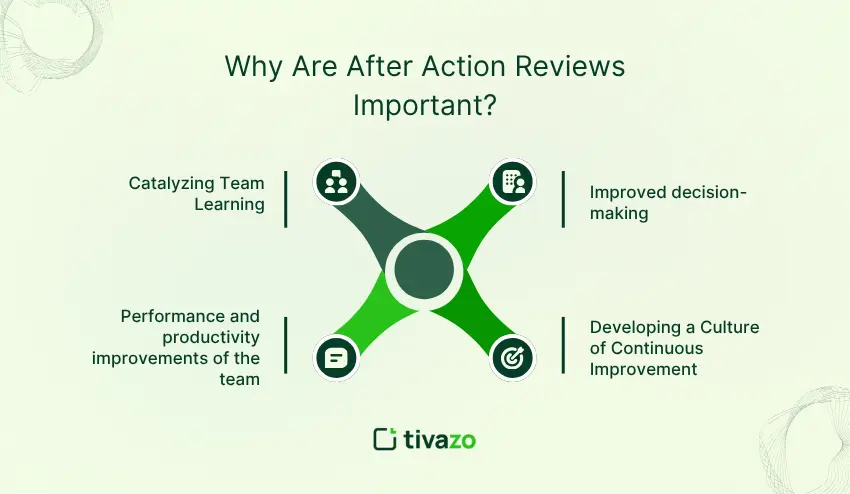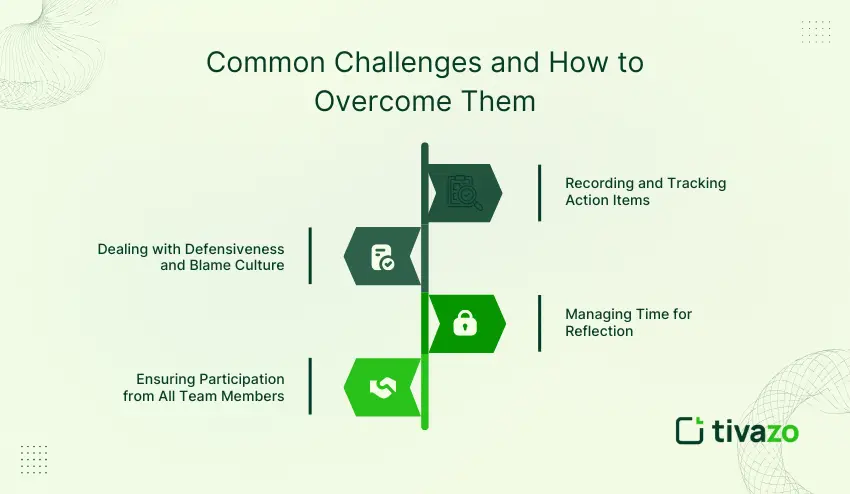Every successful team knows that mistakes are unavoidable, yet replicating the same mistakes has repercussions. Picture wrapping up one project only to face the same problems again. After Action Reviews (AARs), provide a solution: structured conversations on experience that generate actionable insights to help teams continuously improve and deliver better outcomes.
This guide will cover everything you need to know about after action reviews, what they are, why to use them, and how to conduct an after-action review, including step-by-step instructions, templates, common pitfalls, and specific tools to simplify the process. So whether you’re part of a corporate team, a non-profit, or an Agile squad, or just want to improve your personal workflow, these will help you learn faster and deliver better results.
We’ll start off by discussing what an after action review actually is, why it is important, and how it changes how teams are able to reflect, learn, and improve. By the end, you will have actionable ideas for conducting AARs that can actually lead to improvements.
What Is an After Action Review?

After Action Reviews, or AARs, is a process that will help business teams reflect on the execution of their projects, campaigns, or events, and review what happened, why it happened, and ultimately if the performance can and should be improved in the future. Unlike a more casual team meeting, an AAR follows a clearly defined process that results in useful, actionable statements and outcomes, and ensures lessons learned are implemented internally, with the hope of improved performance, productivity and/or outcomes.
In the world of work, AARs have proven to be a useful tool for project teams, marketing departments, operations teams, and leadership/commercial teams in their evaluations. A leading use of AARs is to reflect upon projects and the significance of both successes and gaps, ultimately building the team’s ability to amend workflows and avoid making similar mistakes in the future. Implementing regular After Action Reviews can and will build a larger culture of organizations around continuous learning, while sharing accountability across teams.
While After Action Reviews have similarities to post-mortems and retrospectives, they are distinct processes. Post-mortems tend to focus more on a failure after the project is complete, and retrospectives generally articulate back to a cycle in Agile sprints. AARs, specifically, will look at both success and roadblocks to success and facilitate a more upfront and honest discussion, focused on lessons learned to identify actionable recommendations moving forward, rather than focusing on the work of assigning blame.
Why Are After Action Reviews Important?

1. Catalyzing Team Learning
In business, sharing and inculcating knowledge is very important. After Action Reviews (AAR), are space designed specifically for a team to discuss the successes and challenges that teams have faced during the execution of the project. The team will discuss everything that transpired throughout the project, so that individual lessons learned can be transferred/shared to enhance the organization.
The team members will share what worked, what didn’t work, thus learning individually, and even more importantly, collectively as a mechanism for having both continuous ongoing feedback, standardizing best practices, etc. Another added benefit of an AAR, is cross-department collaboration between teams.
2. Performance and productivity improvements of the team
After action reviews allow the team to look for and fix inefficient processes, resource allocation, or systems. As a project team works, it typically begins to recognize things that took too much time, or were bottlenecks – they then will be able to implement them before they go to their next project. Over time, when you are reflecting on projects over and over and changing processes, you’ll see measurable differences in project outputs, including productivity, completion time, and overall performance outcomes.
3. Improved decision-making
Organizations that consistently use After Action Reviews, most likely decision-making will improve and you will have to make better-informed decisions in the future. Insights gained from AARs can help inform and assist your managers in resource allocations, risk-taking, and supporting a prioritization in their work. Takes the guesswork out of what did or did not work, and also improves impact and projects to come.
4. Developing a Culture of Continuous Improvement.
Conducting After Action Reviews regularly indicates that learning and development are appreciated. Staff members are motivated to express their feedback freely, concentrate on solutions instead of blame and help the organization to improve. Such attitude enhances the engagement of teams, accountability and flexibility which are key attributes of success in competitive markets.
The Core Four Questions of an Effective After Action Review
1. What Was Supposed to Happen?
This question establishes the level of reflection. In a business setting, it is regarding the clear definition of project goals, desired results, and KPIs. The first plan or strategy is checked by the teams, and all people know what should be done. As an example, one of the sales teams may report that they had a goal to make 50 sales within a quarter or convert 10 percent more leads.
2. What Actually Happened?
Then the team analyses the actual outcomes. This involves checking data, metrics, and observations to figure out the differences in the plan. An example of this is that the sales team may discover that they only made 40 deals because they missed follow-ups or failed to nurture the leads. Here it is more about facts, rather than blame.
3. Why Did It Happen That Way?
This step is going to drill down into the success and the failure. Team will reflect on factors that contributed to the outcomes, for example, any process gaps or resource constraints or communication failures, or unforeseen market conditions. The marketing team may have realized that it took beyond the intended amount of time to get approvals to launch the campaigns, or that something in the messaging was more impactful than expected. Identifying restricted reasons that led to failure and to success provides and strengthens practices to repeat when success occurs.
4. What Could Be Better Next Time?
The last question is concerned with actionable recommendations. Teams provide a clear course of action to be improved, duties to be assigned, and follow-ups. As an illustration, the sales department can introduce a uniform follow-up timetable, a CRM automation system, or offer extra training to staff members. The idea is to make sure that lessons will be converted into real performance improvements.
How to Conduct After Action Reviews
1. Preparation: Setting Objectives and Gathering Data
Prior to starting the AAR, it is important to determine the intentions of the review. Determine the project or event you would like to analyze, what you are expecting to learn, and the measurements that will be determined. Collect relevant data that will be applicable, such as reports, performance dashboards, and comments from stakeholders. Further, it can be useful to invite all relevant stakeholders to have a diversity of voices or perspectives, and to provide a fuller picture of what took place.
2. Facilitator Role: Facilitating the Discussion
A skilled facilitator helps to keep to the topic of the conversation and can help to ensure that the work is constructive and engaging for all its participants. In professional settings, the facilitator could be a manager, supervisor, or human resource professional. The facilitator should be skilled in involving others in the discussion and managing the conversation so that there are no comments publicly blaming people for their performance.
The facilitator should help to manage conversations so they can have a deeper conversation around what happened without worrying about any future consequences for the discussions they have at the AAR. Neutral facilitation and a basic understanding of the participants and context can help to keep the participant feeling psychologically safe enough to be honest in the conversation. Facilitating after-action reviews and reflections prepares the group for candid and actionable feedback.
3. Conducting the Review: Structured Dialogue
Throughout the process or the discussions keep referring to the four core questions as a template: what should have happened (could be called anticipated), what has happened, why did that happen, or potential fixes going forward. I would have each, if possible, come prepared with specific data from their reports, dashboards, etc. Identify case studies in the data and focus on conversation and learning, rather than assigning blame for future action.
Best Practices: Dos and Don’ts
Dos:
- Keep the discussion fact-based and data-driven.
- Celebrate successes as well as address challenges.
- Assign clear action items and responsibilities.
- Keep sessions time-boxed to maintain focus.
Don’ts:
- Avoid blaming individuals or teams.
- Don’t skip documentation—capture insights for future reference.
- Don’t rush through the session; meaningful reflection takes time.
After Action: Putting Lessons Learned into Practice.
Summarize important findings in a report or shared document after the AAR. Give follow-up tasks, monitor progress and incorporate lessons into subsequent projects. This measure will help to make sure that the insights obtained will result in real changes that will be used to strengthen the culture of a continuous learning process in the organization.
Common Challenges and How to Overcome Them

1. Dealing with Defensiveness and Blame Culture
One of the biggest hurdles in corporate After Action Reviews is team defensiveness. Employees may fear criticism or repercussions, which can stifle honest feedback. To overcome this, establish psychological safety by emphasizing that After Action Reviews focus on processes and outcomes not individuals. Facilitators should model constructive language and encourage solutions-oriented discussions.
2. Ensuring Participation from All Team Members
Some team members may stay silent, allowing only the most vocal voices to dominate the conversation. Encourage full participation by using structured formats such as round-robin sharing or anonymous input tools. Assigning pre-work or sharing discussion prompts in advance can also help quieter team members prepare meaningful contributions.
3. Recording and Tracking Action Items
Insights become irrelevant if they are not noted and put into practice. Omitting to write down any decisions, recommendations, or action items is one of the most common traps to fall into. Maintain a shared record of the document recording the AAR processes, the members/teams called out for the action items, and the due dates assigned to every action item. Consider utilizing project management dashboards like Trello, Asana, or Confluence to monitor implementation.
4. Managing Time for Reflection
Teams, associates, and corporate teams rarely have time to devote to reflection. Time-boxed sessions of group reflection and limiting the reflection to only the most essential lessons learned are worth considering. Frequent and short After Action Reviews will be more efficient after milestones have occurred, rather than lengthy and sometimes rare AARs at project closeout.
Common Mistakes in After Action Reviews
- Focusing Just on Failures
- When you ignore what has gone well, it presents risk and can hinder motivation to continue the positives.
- Acknowledge what has gone well with what has gone wrong for a balanced view to allow for learning and actions for improvement.
- Neglecting To Record Or Assign Action Items After
- If lessons are not written or assigned in action items, the learning will not be utilized or developed.
- Keep a running group note sheet or board with lessons learned, who will be responsible, and by when it will be done.
- Too Long, Or Infrequently Conducting After Action Reviews
- After Action Reviews that happen a week to months after the project concludes are at risk of being irrelevant or difficult to remember.
- After Action Reviews should take place soon after an event or phase of a project and should become part of your ongoing process to continually improve.
- Too Structured/Unstructured
- If you schedule an AAR that is too structured, it may shut down the open and honest dialogue; if the AAR does not have structure, it can become easy to lose focus.
- Have an agreed-upon structure (the core four questions) but provide an open, non-judgmental environment to allow for candid input.
- Not Going Deeper than the Obvious
- To stop the dialogue and learning from what went wrong and what went well is an opportunity for making the same mistakes again.
- Encourage the groups to not just address the problem with process, but also with context, leading to a new possible actionable direction.
Improving AARs Through Technology and Tools
Increasingly, modern organizations use digital tools to support their After Action Reviews (AARs) and make the findings more actionable. Technology can help eliminate time spent collecting data, create templates for consistent reporting, and aid in collaboration, especially for teams who may be coworkers, but not co-located.
1. Digital Collaboration Platforms
Software applications, like Microsoft Teams, Slack, or Google Workspaces, create the potential for teams to conduct After Action Reviews asynchronously. AARs can be conducted in a dedicated channel for “{project name}”, where team members can log their post-live project review, solicit comments from all team members, and capture the discourse in the channel during the entire review process, all while using one platform.
2. Project Management Tools
Using a project management Application, such as Asana, Trello, or ClickUp, integrating After Action Reviews into an existing tool with teams are used to communicating through. Most project management applications can track actions, assign responsibilities, and the owner can follow up with action items and updates to ensure AARs lead to improved performance.
3. Tools for Data Visualization and Reporting
In order to visualize After Action Review’s results, organizations that handle complex data can apply such tools as Power BI or Tableau to make them more transparent and appealing. Charts and dashboards help leaders to monitor trends, identify the problems that occurred regularly, and present the lessons to the executives or clients.
4. AAR tools and Retrospective tools
Some tools like TeamRetro, Parabol, and FunRetro are specifically designed for structured reviews as dedicated AAR or retrospective tools. These platforms provide built-in templates, the ability to provide feedback anonymously, and offer analytics that add transparency and clarify for teams or organizations.
5. Knowledge Management Systems
Companies that want to share findings from After Action Reviews long-term can store reports on knowledge management platforms like Notion, Confluence, or SharePoint. Over time, a knowledge base is created, and a searchable learning repository is built that can support future projects and onboarding.
Conclusion
In a world where speed and responsiveness are key competitive advantages, After Action Reviews (AARs) represent one of the simplest and most powerful organizational learning tools. AARs create space for teams to pause, reflect, and improve; they can turn day-to-day activities into rich learning experiences.
When applied consistently, AARs develop a culture of accountability and continuous improvement. Teams stop learning from their mistakes, instead, executing better, collaborating faster, and building confidence. Whether you manage a small department or a size of a size at least at the enterprise level, when you intentionally practice AARs, your forward momentum never grinds to a halt. After Action Reviews build forward momentum in your organizational mission.
The time is now to think of reflection as a habit, not an afterthought. Start using After Action Reviews in your workplace today witness big jumps in team performance, alignment, and innovation.




